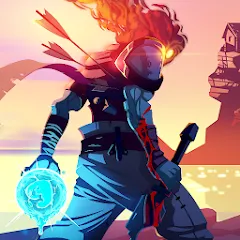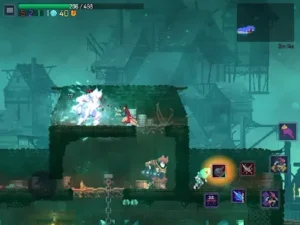
Ben 10 Protector Of Earth
Adventure

| App Name | Dead Cells Mod Apk |
|---|---|
| Latest Version | v3.5.6 |
| Last Updated | 17 Mai 2025 |
| Publisher | Playdigious |
| Requirements | Android Android 7.0+ |
| Category | Adventure |
| Size | 52MB |
| Mod | Mod Menu |
| Google Playstore |

|
“Dead Cells” isn’t just another indie game—it’s a powerful example of how a well-executed concept can captivate gamers and critics alike. Developed by Motion Twin, this rogue-lite Metroidvania hybrid brings together intense combat, strategic exploration, and beautifully animated pixel art into one thrilling package. Since its release, it has become a cult favorite, not just for its gameplay mechanics but for its unique approach to storytelling and game progression. Unlike traditional games, “Dead Cells” thrives on unpredictability, making each run a new experience.
The heart of Dead Cells lies in its fluid combat system, where every swing, dodge, and jump feels meticulously crafted. The game rewards precision, timing, and tactical thinking, combining these elements with randomly generated levels and permadeath mechanics. Players aren’t just pushing forward; they’re learning, adapting, and evolving with each playthrough. This ensures that even after dozens of runs, Dead Cells continues to feel fresh, engaging, and rewarding—a true hallmark of great game design.
Motion Twin’s creative design choices also make Dead Cells more than just a challenge. The developers intentionally built a world that reveals its story through environmental cues and small hints, avoiding heavy-handed narratives. This gives players the freedom to interpret the lore on their own terms, drawing them deeper into the mystery of the island and the beheaded protagonist. It’s a fine blend of minimalism and richness that few games manage to balance so elegantly.
At the core of Dead Cells’ brilliance is its real-time combat, which blends fluidity with intensity in a way that’s hard to match. Whether you’re slicing through enemies with twin blades, launching grenades, or freezing foes with magical attacks, every weapon has a unique feel that adds to the game’s versatility. What sets Dead Cells apart is that it doesn’t just encourage experimentation—it demands it. No two runs are ever the same, and players must adapt their playstyle based on the weapons and items they find.
This fast-paced combat is complemented by a tight and responsive control scheme. Movement feels snappy and satisfying, which is essential in a game where quick reflexes mean the difference between victory and defeat. Dead Cells makes you feel in control at all times, yet constantly on the edge, dodging traps, executing perfect rolls, and chaining attacks like a seasoned warrior. It’s a thrilling dance of action that pushes you to master its intricacies while still being accessible to newcomers.
Another crucial aspect of combat lies in the synergy between items, skills, and stats. The game’s three upgrade paths—Brutality, Tactics, and Survival—allow players to shape their runs according to their preferences or circumstances. Each stat influences health, damage, and item effectiveness, adding a strategic layer to progression. Choosing between high-damage melee builds or long-range tactical ones becomes a calculated risk, adding weight to every decision you make.

Dead Cells thrives on its rogue-lite structure, which ensures that no two gameplay sessions are ever identical. Players start each run from the beginning, losing most of their items upon death but retaining certain permanent upgrades. This system brilliantly balances punishment and reward, making every death a learning experience rather than a failure. It keeps players engaged, curious, and constantly improving their strategies to go further with each attempt.
One of the game’s most commendable features is its procedural level generation. The game’s biomes are not static; they change layout, enemy types, and loot locations with every new run. While key progression points remain intact to avoid confusion, the randomness injects excitement and unpredictability into each session. Players never feel like they’re repeating the same path, even after dozens of hours, which is a huge accomplishment in a genre where repetition can become tedious.
Beyond levels and loot, the game features various branching paths and secrets that reward exploration. These choices not only add narrative flavor but also cater to different playstyles. Want a shorter but harder route? Or a longer, safer one? The options are there. With multiple endings, daily challenges, and additional difficulty levels that unlock new content, Dead Cells provides an almost infinite loop of discovery and challenge.
Visually, Dead Cells is nothing short of breathtaking. Its handcrafted pixel art style is rich with detail, fluid animations, and vibrant colors that pop off the screen. Every biome has a distinct aesthetic—from the eerie toxicity of the Sewers to the majestic gothic spires of the Castle. This visual diversity keeps players immersed and eager to see what lies beyond the next doorway. The animations, particularly in combat, are smooth and stylish, making every kill visually rewarding.
The worldbuilding in Dead Cells is subtle yet effective. Instead of lengthy cutscenes or dialogue, players glean the story through background elements, cryptic notes, and scattered clues. This indirect narrative style allows players to piece together the lore at their own pace, creating a sense of mystery and personal investment. It’s a storytelling method that respects the player’s intelligence and encourages deeper engagement.
Sound design also plays a pivotal role in immersion. The soundtrack, composed by Yoann Laulan, is both haunting and energetic, blending atmospheric tones with adrenaline-pumping beats. Each biome has its own musical identity that enhances the gameplay experience, whether you’re cautiously creeping through enemy-infested corridors or battling a screen-filling boss. These audio-visual elements combine to create a world that feels alive, dangerous, and worth exploring.
Even years after its release, Dead Cells continues to dominate discussions around indie excellence. It has received constant updates, DLC expansions, and quality-of-life improvements that show Motion Twin’s commitment to their player base. These additions have introduced new weapons, biomes, enemies, and even crossover content with other games, ensuring that the game remains fresh and exciting for both new and returning players.
What truly sets Dead Cells apart is its ability to appeal to a wide audience. Whether you’re a hardcore gamer looking for a challenge, a casual player enjoying bite-sized runs, or a fan of pixel art aesthetics, there’s something here for everyone. Its pick-up-and-play nature makes it accessible, while its depth and nuance provide ample content for mastery. It’s that rare combination of instant gratification and long-term engagement that makes a game legendary.
To sum up the reasons behind Dead Cells’ lasting success:
A deeply satisfying combat system with endless variation
Visually stunning pixel art and immersive environments
Addictive rogue-lite progression and replayability
Strategic depth and customization through gear and upgrades
Continued support from developers with fresh content and fixes
Dead Cells isn’t just a game—it’s a benchmark. It represents what’s possible when passion, creativity, and smart design come together. In a sea of indie titles, Dead Cells stands tall not just as a genre-defining game, but as a modern classic that future developers will look to for inspiration.
You Can Also Download This From Our Website ApkVisione